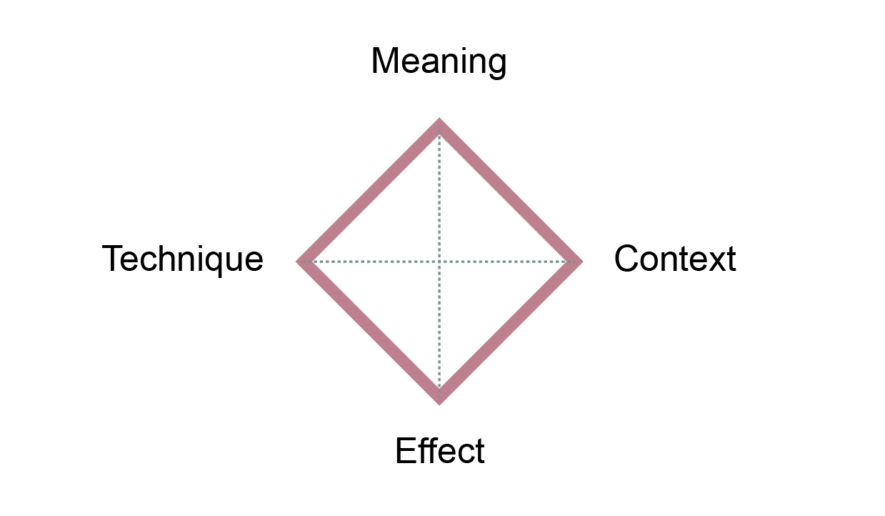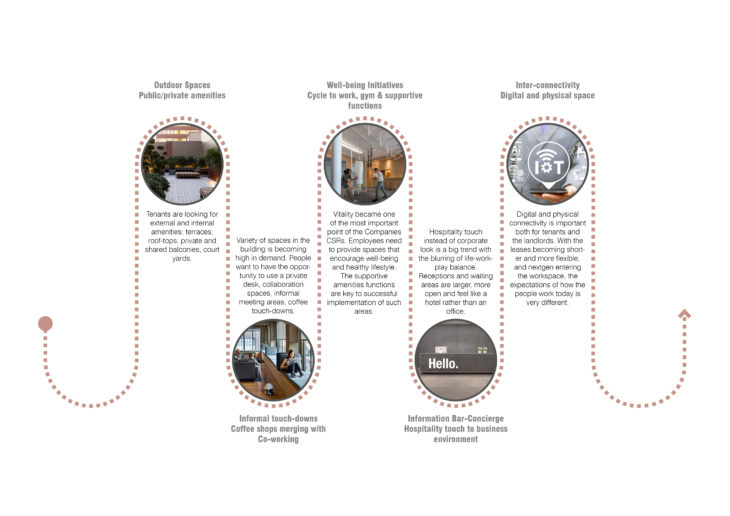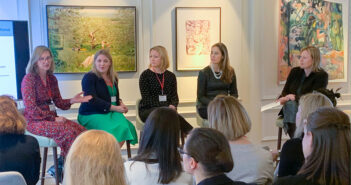What distinguishes a fantastic performance from a not so great one?
Can we use the same frameworks to evaluate a theatrical performance, to a business one?
What is the link between context and performance measures?
This article analyses a diamond framework used within the performative arts context in a lens of other industries and establishes interlinking connections between its nodes to drive the performance metrics up.
In a context of theatrical performance, during a conversation with a talented producer (who prefers to remain unnamed), I came across an intriguing framework (Figure 1). The framework looks like a diamond with the following headings: meaning, context, effect, technique.

Figure 1. The Diamond framework. A.Kulik,2020
Every performance should have a meaning, an intention. It will be created and judged within a setting – or context. The audience will be concluding on whether the original meaning and intention, your goal, results in a desired outcome and effect. Inevitably, the observer will assess the technique or the quality of the delivery, precision, execution.
There are a couple of things that I found interesting in the discovery of this framework. Firstly, this framework is not only applicable to theatre and performative arts.
I can think of equally applying the framework to evaluate business performance, athletic performance, personal performance, or even building or product performance. In other words, it is a tool to analyse a wide range of projects. For example, if I were to look into a building fabric or a generic architectural proposal, the below would be the questions following the nodes of the above diamond closely.
- What is the intention of this architectural proposal?
- Is it fit for its context, and how does it interact with the urban fabric?
- Is the concept followed through to the extent that the meaning is resulting in an effect? Are people using the building in the way of how the architect intended it to be?
- Finally, the devil is in the detail. As a professional, I can be observing and discussing the quality and technique of design detail and construction execution endlessly.
Building evaluation fits comfortably within the diamond. A second finding in the framework is the cross dependency of the opposing nodes of the diagram. The effect connects with the meaning in an unbreakable link and the context – with the technique.
To demonstrate my thinking within a more diverse application range, the following example – meaning to effect – is within a leadership area rather than the architecture industry. Here, I am resonating with « What Leaders Really Do » by John Kotter, one of the Harvard Business Review all-time favourites.
First comes the meaning, then the effect. From the way of how you communicate your purpose, set a direction, align people and motivate them around your vision will result in you as a leader and your business collecting the fruits. Only with a rightfully communicated vision and strong leadership, you will receive the positive results, have a more productive and happy workforce, delivering your goal and idea; in other words, achieve the desired effect.
The context and technique are equally connected. Moreover, I see the link happening over the two levels: the level of development and the level of delivery.
The right context can allow one to learn and build upon one’s knowledge, develop the skills and technique. Employees who enjoy and like the environments are more engaged, productive, happy, and healthy. There are numerous studies such as Gensler’s Workplace Index that explore the relationship between physical space and business performance metrics, employees productivity and engagement. The metrics suggest that the employees are 76% more productive in a pleasant environment where they have a variety of choice. Balanced workplaces result in 78% of creative thinkers, compared to 56% in the unbalanced workplaces.
The fewer distractions related to the facilities there are, the more focused and keen on improving the employees become. Equally, the spaces that are not fit for purpose and have a poor setting will result in an unmotivated workforce and weaker delivery skills.
In a constant war for talent, employers are racing to provide better, more diverse and vibrant facilities in their office space environment. Research proves that having outdoor private and public amenities, visual and digital connectivity, high-quality fit-outs with the tools fit for purpose reduce the turnover of staff and become an appealing recruiting aspect for the new-comers. Like a chain reaction, developers and landlords are keen to provide more facilities to respond to those needs, and as a result, to be more competitive for the market. Developers are willing to spend more capital up-front, creating higher standard spaces. Well-certified buildings are becoming more like a norm rather than a trend. Below is just a snapshot of the trends that are becoming a norm within London workplace environment. 
Figure 2. Business Space trends. A.Kulik,2020
An interesting observation comes to mind at this point. While the employers finally understand the effect of the environment on their workforce and see the economics of productivity to justify the investment for facilities improvement, it only happens within the business space environment. We will see much less comparable investment going into education or performative arts spaces and training grounds.
The second level linking context and technique is during the delivery of the performance, and subsequently, the judgement by others. Let’s review this link in the world of the performative arts.
Another fascinating case study provided by Harvard Business Review, speaking of the Cirque du Soleil reinventing the industry and creating a new market space by challenging conventional assumptions about a circus. The case discusses how drawing upon the distinctive strengths of other alternative sectors, such as the theatre, Cirque du Soleil was able to offer a new set of utilities to more mature and higher spending customers.
Changing the setting with comfortable chairs for the audience, beautiful costumes, a story, music, lighting allowed Cirque du Soleil to change the perception and the way of how the spectator consumed the show – it is all about context, in the level of the delivery.
Finally, the last – yet obvious – observation of the framework.
When evaluating the performance of the show, business or a person, every single node of the framework is equally valuable. Failure of either of the nodes will result in a weaker score of the product/performance/achievement/effect overall.
Some people may argue that the meaning and effect are the more critical facets of the diamond. To an extent, in the sense of an organisation, I would agree – it is unlikely to be able to motivate people and align them around a no-vision and no sense of purpose, without sharp or unfocused leadership in place.
However, in the world of entrepreneurship and creativity, the context may play a far more critical role for an individual or a group of people. Take a look at shared working spaces like WeWork, that created motivation, engagement and inspiration to different groups and organisations within the same area, through the tools of design, digital connectivity and engineered serendipity.
The diamond works when all the nodes are very much engaged. Have a meaning, so you can establish a direction and steer towards the right route. Understand the context where your vision sits. Create a setting to develop the right level of technique. Use this technique within the proper context to smash your performance.
Those are essential ingredients to put one on the path to perfection and creativity.
Anna Kulik moderates MIPIM 2020’s Pecha Kucha session, and « A conversation with Philippe Starck ». More info here



